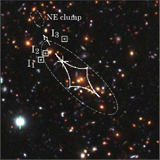Research Gallery > Extragalactic Astronomy
Research Gallery
Extragalactic Astronomy
| Subaru/Suprime-Cam image of the distant cluster RXJ0152 at z=0.83 |
|
Image Credit: Muller and Umetsu et al.

Top: Measurements of C, N, O and S isotopic abundance ratios in the arm of a spiral galaxy at a redshift of z=0.89 using the Plateau de Bure Interferometer. The galaxy is located on the line of sight of a distant quasar (PKS 1830-211) and acts as a gravit
|
| Light from distant galaxies carry precious information on the history of the Universe, even though they tend to be extraordinarily weak. One common yet powerful technique is gravitational lensing. A massive object, such as a galaxy or a cluster of galaxies, presents a strong gravitational potential, which focuses and amplifies the light rays from a background source. Strong gravitational lensing is also responsible for multiple images and/or highly magnified giant luminous arcs of background galaxies. Such strong lensing phenomena can be used to determine the distribution of mass in clusters regardless of the physical/dynamical state of matter in the systems. A detailed modeling of the lens mass distribution is essential in constraining the global geometry and topology of the universe. Absorption features in the spectra of distant quasars passing through a galaxy can probe the chemical evolution of the young universe. Our observations show that isotopic ratios, especially the 17O/18O and 14N/15N ratios, in a distant spiral galaxy is significantly lower than those observed in the Milky Way. |
 asiaa.sinica.edu.tw Media Request: epo
asiaa.sinica.edu.tw Media Request: epo asiaa.sinica.edu.tw
asiaa.sinica.edu.tw 